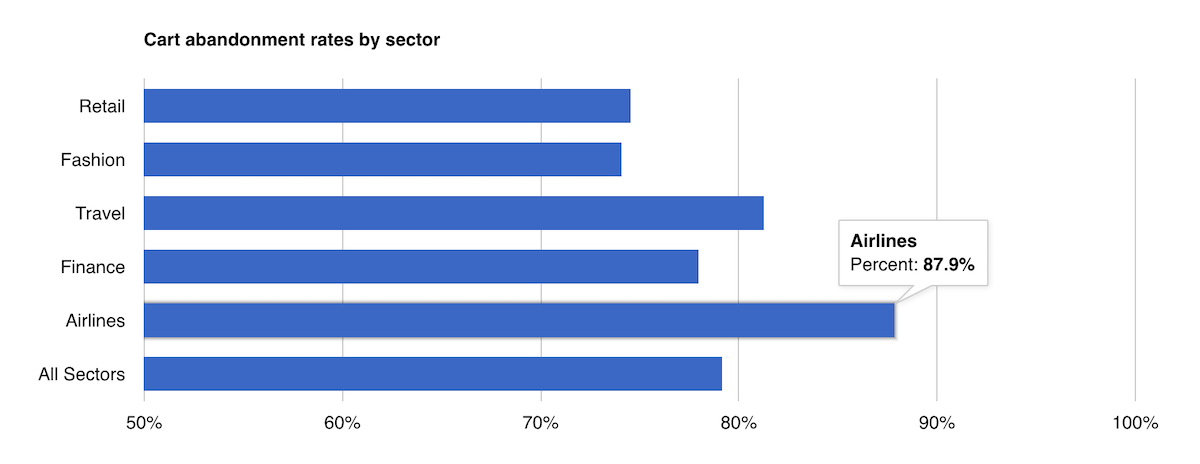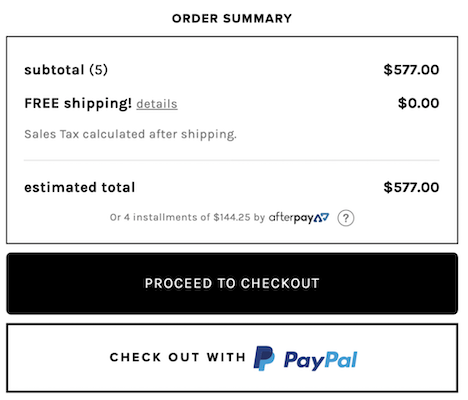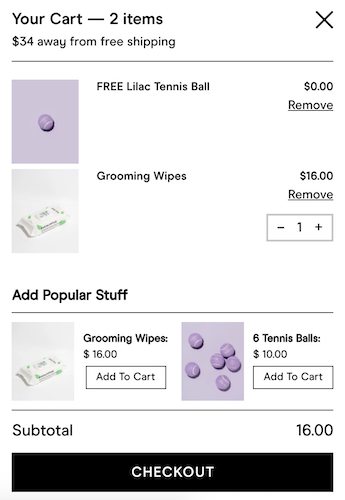In the ecommerce world, shopping cart abandonment is all too common. Sometimes people see the total price in their cart and they get cold feet. Other times they get distracted and forget they even filled up a cart. This phenomenon is unlike the brick and mortar shopping experience.
In physical retailers, people don’t usually fill up their carts and then simply walk out of the store. The problem of shopping cart abandonment is directly tied to ecommerce, and as more businesses open online stores, the issue isn’t going away.
Shopping cart abandonment statistics
Based on data collected from 41 different studies on abandoned shopping carts, 69.57% of shoppers leave without purchasing. This abandonment adds up. Ecommerce stores lose over $18 billion in yearly revenue.
Here are some other shopping cart abandonment statistics to give you an idea why this problem can’t be ignored:
- Extra costs like shipping and being forced to make an account are the two main reasons shoppers abandon their carts (Source)
- Mobile users have the highest rate of abandonment at 85.6% (Source)
- Airlines and travel have the highest shopping cart abandonment rates (Source)
- With better site optimization, 35.26% of lost sales can be recovered (Source)

Here are some foolproof ways to look at the customer journey and lower the rate of cart abandonment.
How to reduce shopping cart abandonment
With shopping cart abandonment rates so high, there are many strategies to reduce this issue. Using a combination of the following tactics is a surefire way to decrease the number of people leaving without purchasing.
1. Provide seamless payment processing
Payment processing is complicated behind the scenes, but to customers, it should only take a fraction of a second. The goal of reducing abandonments here is to have the least amount of work in the shortest amount of time.
First, make sure you have trustworthy payment gateway software. People still don’t trust giving their personal information online, so choose software that makes security their number one priority.
Also, give your shoppers more than one payment option. Let them connect to Paypal, Apple Pay, or Amazon Pay so that they don’t have to enter their credit card information.
If they elect to pay by credit card, allow them to save their payment information so they don’t have to re-enter it the next time. Additionally, you can offer payment plans that allow shoppers to make monthly payments on their purchase. Things like allowing shoppers to click, “same as shipping address” saves time. The fewer hurdles for paying, the better. Check out the Revolve example to see how they simplify the payment processing.

2. Exit-intent pop-ups
Pop-ups are a simple way to give shoppers an extra second to think before X-ing out for good. Most, if not all, exit intent pop-ups feature an offer to incentivize the shopper to stay on the page and purchase what’s in their cart.
3. Improve CTAs
Improving user experience is crucial to lowering shopping cart abandonment rates. Keep the language on your ecommerce website simple and clear. Don’t be clever with your CTA buttons, instead use an action verb that tells people precisely what action to take.
In Wild One’s example, the language is abundantly clear. It tells the shopper how much they need to add until free shipping is given, and then suggests “popular stuff.” It also makes removing items very simple with one click. Lastly, the checkout button is the largest on the page:

4. Offer free shipping
People hate paying shipping costs. With companies like Amazon Prime offering free two-day shipping, people will abandon their carts if they see there’s no free shipping. If you can’t afford free shipping on all products, set a minimum price that shoppers must match to receive free shipping. Most of the time, shoppers will pick the cheapest shipping option regardless of how long they have to wait.
Do everything you can to offer free shipping, as this is one of the biggest reasons for shopping cart abandonment like Mejuri does in the example below:

5. Retarget with display ads
After someone closes out of your ecommerce site, remind them of their cart with retargeting display ads. Below is an advertisement that appeared on Facebook after $577.00 of merchandise was abandoned. This is an effective way to get people back and complete their purchase. Revolve is very good at following you around after abandoning a shopping cart:

6. Follow up via email
Another way to entice people back onto your website is by following up via email, like Wayfair, after they exit your online store. Either present an intriguing offer or remind them of what they’re missing out on.
You can either be direct and say something like, “We already miss you!” Or you can be indirect like the email below that promotes product categories. In the Wayfair email, the word sale and savings are in the subject line, the item I was about to buy is mentioned, and free shipping is offered. All of these combined incentivize people to complete the purchase.

7. Allow cart saving
Have you ever filled up your cart, walked away for a minute, and your entire shopping cart disappeared? This is an extremely frustrating experience and often leads to a customer abandoning that purchase entirely.
Even if the shopper doesn’t have an account, save their cart as a courtesy. Once the items are lost, the chances of the shopper re-filling the cart are slim to none.
8. Enable guest checkout
Guest checkout is a must. When consumers see that they must have an account, they automatically think it will take longer to create a profile and receive promotional emails from your online store.
Allow your shoppers the choice to sign in to an existing account, create an account, or check out as a guest, like Yeti.

9. Add a progress indicator
Remember that your shoppers might not be tech-savvy. They may not know how many more steps are required until their purchase is complete.
Create a progress indicator that shows shoppers where they are in the checkout process. Doing this allows them to analyze if the steps remaining are worth the purchase. So it’s in your best interest to keep these steps to a minimum.
10. Include scarcity details
If consumers see limited quantities remain, they’ll be more inclined to act instead of delaying a purchase or abandoning altogether and thinking before purchasing. In the Free People example below, the product page says “only a few left.” This detail highlights that it is a popular item and may not be available if they don’t act fast:

11. Use social proof
Social proof like customer reviews is great for limiting cart abandonment. So, offering a product review section allows other shoppers to read testimonials before purchasing. This functionality reassures buyers to check out more quickly.
If your product generally receives positive reviews, people will speed up their decision-making and purchase in confidence. Consider using social media advertising to spread your positive reviews and target new customers or retarget old ones.
12. Reduce page load time
If your page loads too slow, you’ll lose customers. It’s unfortunately common that the largest slowdown occurs when customers are checking out, and when this happens, shoppers abandon their carts.
Don’t only focus on the desktop experience. Many people use their mobile devices to shop, and if the page isn’t optimized for mobile, you’ll leave money on the table.
Conclusion
The 12 tips above will limit your cart abandonment rate, but neglecting to personalize the shopper’s journey can lower your ecommerce sales, too. Create the same post-click landing page that you establish at the pre-click level, and your customers will reward you in turn. To learn how to create personalized post-click landing pages at scale, request an Instapage Enterprise demo.

See the Instapage Enterprise Plan in Action.
Demo includes AdMap™, Personalization, AMP,
Global Blocks, heatmaps & more.
